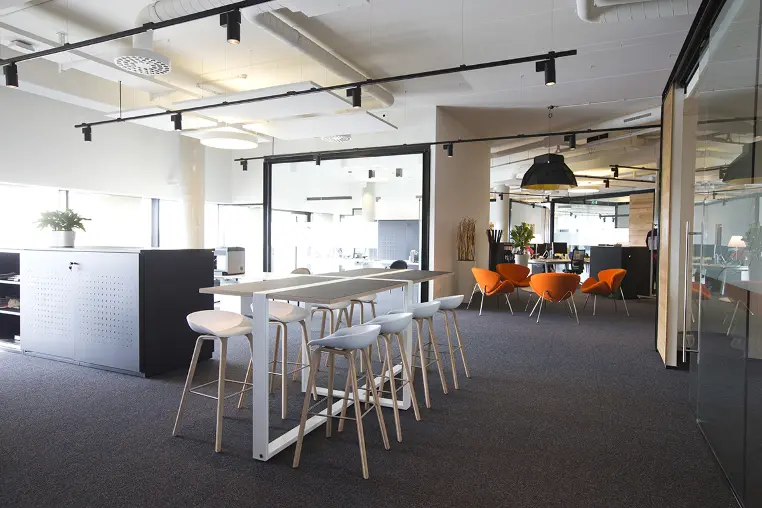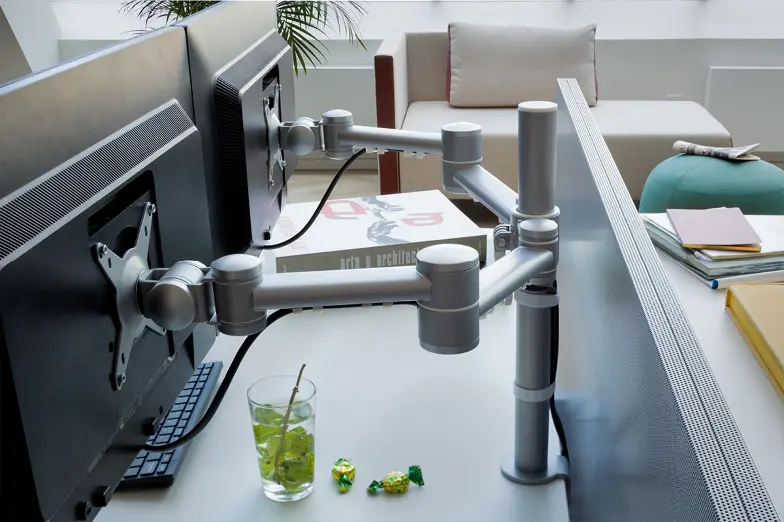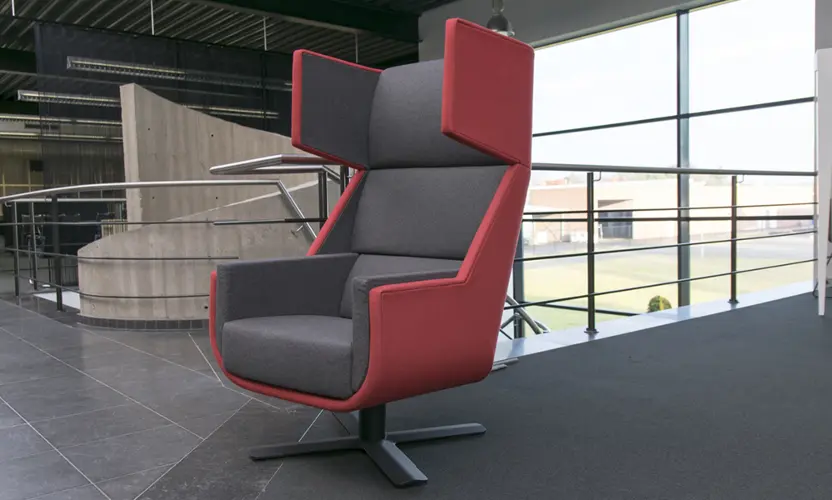De Voorzorg

Ergonomics and a warm work environment as key design features.
Dark floors, iron waiting benches, brown ceilings in metal slats. That is what the offices of De Voorzorg in Mechelen look like. Or rather, that is what they used to look like. After updating their corporate values, it was time to subject the offices to a thorough rejuvenation treatment as well. And so it happened, to the great satisfaction of staff and visitors alike.
We met Buildings and Logistics Director Tom Verbruggen in one of ‘his’ new lounges in Mechelen. It was striking how the tone of the conversation adopted the warmth of this meeting place right away. Not a bad way to start the evaluation of this radical interior project, we thought. But as it turns out, no evaluation was needed.
Tom Verbruggen: “De VoorZorg is a warm organisation that represents boldness, solidarity and engagement squared. Our old interior was the exact opposite. It made no sense whatsoever. We briefly considered the options of rebranding the old interior as ‘vintage’, which would have saved us a lot of money’, he laughed. But those offices were quite simply outdated. And completely spent.
By using organic materials, homey elements and warm colours, we managed to reflect our values in our interior. This is important, but what matters most is that we took a huge leap forward in terms of our work environment.”
What does that leap entail exactly?
“Firstly, we wanted to improve our visitor experience. After all, we are here for them, not for ourselves. Several new concepts fitted that mould based on the expected contact duration or the desired level of privacy. As a result, a clear distinction arose between the reception counter, where people come to pick something up or get referred, several open counters for activities that take a bit more time and separate rooms for longer meetings in a more private setting.
Members who are asked to wait have access to a waiting area with comfortable seating furniture. Their organic shapes make for a softer atmosphere and they can be arranged as needed. In addition, we have a cosy coffee corner with wi-fi, TV and music. As a result, time flies while you wait.”
How did you go about it?
“The office interior element was part of a complete renovation project. Its architect was responsible for developing the interior concept as well. We needed room for 10 to 15 front-office staff on the ground floor and back-office space for 140 employees on the first floor.
Several internal workgroups had mapped our needs and wishes in advance to provide the architect with a good briefing. This had a significant impact. As did your contribution, by the way. Especially the pro-active approach that Pami took from the first intake all the way through execution, really made a difference.”
Did all employees weigh in?
“In so far as possible, because you need to manage the balance between the available space, ergonomics, price and lots of other aspects of such an assignment. For example, the direct input of employees led us to go for conference tables and H-legged desks with a fingerprint-free top layer. Two justified requests from our maintenance department. These were practical aspects.
When it comes to emotional elements such as taste and colour, it is impossible to argue let alone address all individual preferences. That is why aesthetics were handled by the internal office organisation workgroup in consultation with the architect. And with regards to ergonomics, our prevention advisor was closely involved in the process. These things must be handled by an independent expert.”
What kind of requirements resulted from the internal workgroup?
“First and foremost, the workgroup taught us that we need to divide our specifications into multiple chapters. For our standard workstations, for example, it was OK to focus on technical quality and price. And striking the right balance between the two. But when it comes to designs with more room for creative input, such as a waiting room, coffee corner, lunchroom and such, it was clear that we had to focus on conceptual input more so than on the price.
For those spaces, the specifications were more about what feeling they would have to evoke. For example: ‘a waiting room for a maximum of six people, organic shapes, flexible layout, crisp colours, timeless.’
For the office chairs, on the other hand, ergonomic quality was an absolute priority. This is why an internal workgroup subjected various chairs to an extensive test. The scores were included in the specifications.”
How did Pami deal with this?
“Honestly, Pami stood out based on those focal points. Some other candidates had also submitted beautiful concepts but they failed to match our expectations. As if they had misunderstood us or, even worse, hadn’t truly listened. To me, being able to listen to your client is an important characteristic for any organisation.
Furthermore, some contenders didn’t have the right people to brief our internal team charged with researching office chairs. Pami, on the other hand, provided a very professional and to-the-point explanation.
The way in which your interior architect Bieke Verschueren translated our wishes and needs into a concrete, elaborated proposal played an important role as well. It gave Pami an edge that cannot be understated.”
What other assets does an organisation like yours look for in an office interior design partner?
“Our philosophy is to stick with what you know. So, for a comprehensive project like this one, where 150 people need to be able to work under the best circumstances for years, you don’t want to rely on a quick online search for a box mover who can supply the necessary cabinets, tables and chairs as cheaply as possible.
We set out to find a partner who would be able to support us with well-founded advice from the start when it comes to interior concepts, use of materials, ergonomics, acoustics, etc. while being able to guarantee a top-notch implementation and great after-service.
This is why we opted for a tender procedure (we must adhere to legislation). This allowed us to assign the lion’s share of points based on the conceptual approach and focus less on the price.”
‘The new way of working’ was not a priority for this assignment. Was there a specific reason?
“No matter how you look at it, an organisation like ours still deals with a lot of paper. Our employees and clients usually work with hardcopy files. But of course, we have been moving towards ‘the new way of working’ for several years now too.
Digital document processing is growing exponentially, for example. And we are in contact with the government about the validity of scanned documents and digital signatures. But there is still a long way to go in that regard. Which is why we decided to give everyone a personal workstation in an open-plan office supplemented with several focus workstations where they can withdraw for extra focus.
Some time ago, we kicked off a trial project where our colleagues are allowed to work from home one day a week. Its assessment is a dynamic process and currently underway.”
What is something that you really didn't want to skimp on?
“Ergonomics. As mentioned earlier, we considered it a top priority. Hence our thorough testing of office chairs, for example. If you spend eight hours a day sitting on a chair for several years, the price becomes less important and should always yield to the ergonomic properties of the product. This is why we opted for height-adjustable tables, allowing every user to configure their desk to their own body height.
We considered acoustics an important aspect of ergonomic comfort as well. Which is why we installed acoustic ceilings and cabinet doors as well as partitions and carpets wherever necessary. This combination dampens the ambient sound, filters disturbing noises and creates a calm atmosphere as a result.
Finally, we installed a sit-stand meeting room on each floor. Something we are still getting used to but once the novelty wears off, everyone recognises the benefits. We are also running an internal awareness campaign around the use of those alternative meeting facilities.”
What was the decisive factor that led you to Pami and how did the project go?
“Despite the fact that your price was not the most competitive, Pami scored the highest number of points in our highly extensive tender. In other words, your budget score was easily offset by the scores on criteria such as quality, concept and ergonomics.
Your conceptual input and swift execution of the project added a dimension of value that is difficult to express in financial terms. For example, your flexibility when our street got torn up all of a sudden. Or when other unforeseen circumstances occurred on the construction site, which is inevitable in a project like this one. But Pami’s positive attitude throughout and the way in which you approached the issues that arose, including last-minute interventions, meant that we never missed a single deadline.
A magnificent performance with special credit to Patrick Lehaen for his role on site and Helena Ramos in logistics. Tina Wauters deserves special mention as well for managing communication between all parties the way she did.
A happy customer. Would that be a fair conclusion?
“I would say a very happy customer. Our new work environment was extremely well received. Many spontaneous compliments came our way about the warm atmosphere, comfort, acoustics, etc. This office is comfortable and pleasant to work at and it makes us proud to receive our clients here.”
































































